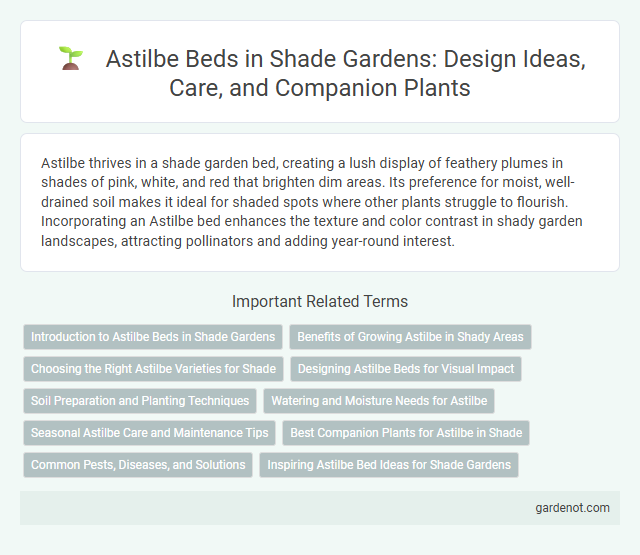Astilbe thrives in a shade garden bed, creating a lush display of feathery plumes in shades of pink, white, and red that brighten dim areas. Its preference for moist, well-drained soil makes it ideal for shaded spots where other plants struggle to flourish. Incorporating an Astilbe bed enhances the texture and color contrast in shady garden landscapes, attracting pollinators and adding year-round interest.
Introduction to Astilbe Beds in Shade Gardens
Astilbe beds thrive in shade gardens due to their preference for moist, well-drained soil and partial to full shade conditions. These perennials produce feathery, plume-like flowers in vibrant colors, adding texture and brightness to shaded areas. Incorporating Astilbe beds enhances garden aesthetics by providing consistent blooms from late spring through summer under tree canopies and shaded borders.
Benefits of Growing Astilbe in Shady Areas
Astilbe thrives in shade gardens by providing vibrant, feathery plumes that brighten low-light conditions while enhancing soil moisture retention. Its deep root system improves soil structure and prevents erosion, making it ideal for woodland or shaded border planting. Astilbe's ability to attract pollinators like bees and butterflies further supports biodiversity in shaded garden ecosystems.
Choosing the Right Astilbe Varieties for Shade
Selecting the right Astilbe varieties for a shade garden involves considering factors such as bloom color, plant height, and moisture preferences to ensure optimal growth. Popular cultivars like 'Fanal' for its deep red plumes, 'Deutschland' with vibrant pink flowers, and 'Sprite' offering compact height excel in low-light conditions and consistently moist soil. These Astilbe varieties thrive in dappled shade, providing lush, feathery blooms that enhance the texture and color palette of a shaded garden bed.
Designing Astilbe Beds for Visual Impact
Astilbe beds thrive in shaded garden areas where they provide striking visual impact with their feathery plumes in shades of pink, white, and red. Designing Astilbe beds involves grouping plants of varying heights and bloom times to create layered textures and continuous color throughout the growing season. Incorporating complementary shade-loving perennials like hostas and ferns enhances the overall contrast and depth, making the Astilbe bed a vibrant focal point.
Soil Preparation and Planting Techniques
Astilbe thrives in rich, well-drained soil with high organic matter, making soil preparation essential for optimal growth in a shade garden. Incorporate compost or aged manure to improve soil structure and moisture retention, ensuring consistent hydration without waterlogging. Plant Astilbe crowns at soil level with adequate spacing of 12 to 18 inches to promote airflow and reduce disease risk.
Watering and Moisture Needs for Astilbe
Astilbe thrives in consistently moist soil, requiring regular watering to prevent the roots from drying out, especially during hot weather. Maintaining well-drained yet moisture-retentive soil is essential to support vigorous growth and vibrant blooms. Mulching around the Astilbe bed helps retain soil moisture and regulate temperature, reducing the frequency of watering.
Seasonal Astilbe Care and Maintenance Tips
Seasonal Astilbe care in shade gardens includes consistent moisture to prevent leaf scorch and encourage vibrant blooms from late spring to summer. Applying a balanced, slow-release fertilizer in early spring supports healthy growth and flower production. Removing spent flower stalks and dividing clumps every 3-4 years enhances plant vigor and prevents overcrowding.
Best Companion Plants for Astilbe in Shade
Hostas and ferns make ideal companion plants for Astilbe in shade gardens, thriving in the same moist, well-drained soil conditions. Heuchera adds contrasting foliage colors and textures while thriving in partial to full shade, enhancing the visual appeal of the Astilbe bed. Tiarella and Solomon's seal also complement Astilbe by contributing unique leaf shapes and subtle blooms that flourish in low-light environments.
Common Pests, Diseases, and Solutions
Astilbe beds often face challenges from common pests like aphids, slugs, and spider mites, which can cause leaf damage and stunt growth. Powdery mildew and root rot are typical diseases affecting these plants, usually resulting from poor drainage or excessive moisture. Preventative solutions include ensuring well-drained soil, applying neem oil or insecticidal soap for pests, and removing affected foliage promptly to maintain plant health.
Inspiring Astilbe Bed Ideas for Shade Gardens
Astilbe thrives in shade gardens, offering vibrant plumes of pink, red, white, or purple that brighten dim corners with minimal sunlight. Combining Astilbe with hostas and ferns creates textural contrast while maintaining moisture-rich soil, essential for healthy growth. Designing layered beds with varying Astilbe heights enhances visual interest, making shady landscapes both colorful and dynamic.
Astilbe bed Infographic

 gardenot.com
gardenot.com